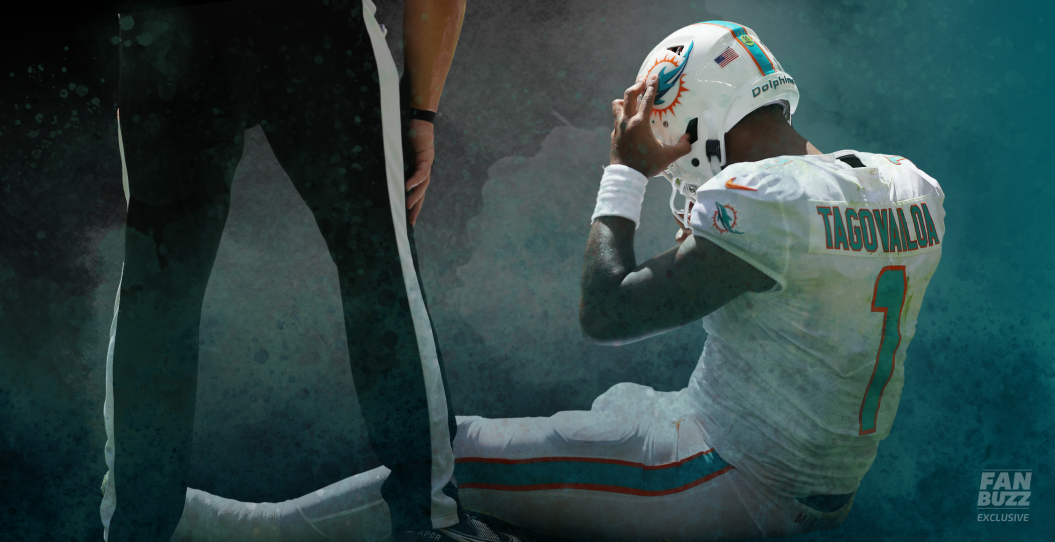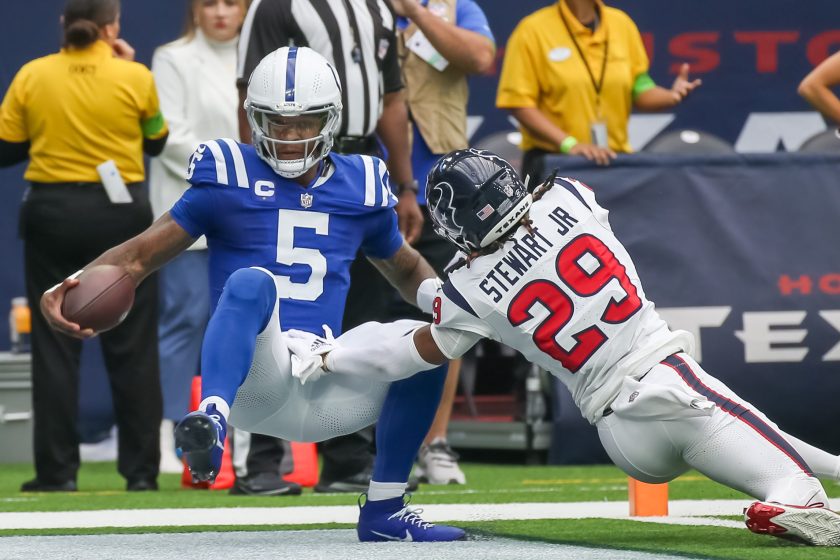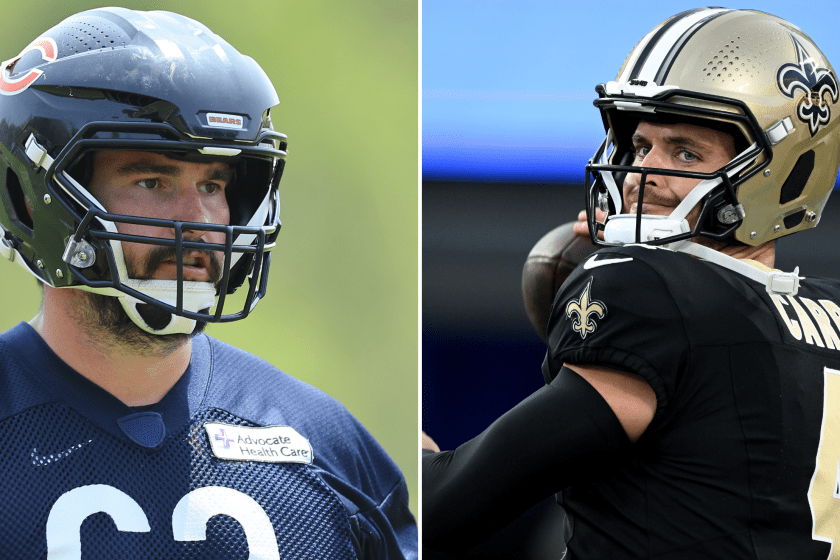Nothing's perfect. After a high profile problem with missed concussion checks last year cost Tua Tagovailoa much of his season, the NFL has another issue on its hands after another missed concussion in Week 2.
Videos by FanBuzz
The problem was with Colts rookie QB Anthony Richardson. Richardson was hit on a rushing touchdown, but no one noted that he'd hit his head against the Lucas Oil Stadium turf as he fell to the ground. Richardson played six more plays before self-reporting that he felt light-headed. He was quickly checked and failed, placing him in the concussion protocol.
In a week where several concussions were notable, including Jaylen Waddle, Jakobi Meyers, Richardson's own center Ryan Kelly, and Logan Thomas, and where star Raiders receiver Davante Adams was checked and returned, the issue simply won't go away for the NFL.
Giving credit where credit is due, the NFL has done better since settling their massive concussion lawsuit years back. They instituted the concussion protocol in line with industry best practices, have improved that where they can, and even adjusted quickly, adding concussion spotters and making sure the independent doctors are truly independent. The league has even go so far as to require Guardian Caps, a large, padded supplement that is worn over the traditional helmet, during the preseason.
As Richardson's concussion was missed, leaving it to Richardson to self-report, we do see that the culture of the NFL in regards to head injuries is changing.
Richardson had enough presence and enough trust to report his symptoms and let the system take place, making sure he's in the best position so early in his young career. Others, especially those fighting for jobs and playing special teams, might not be as willing to say so.
This leaves many asking: What more can be done? The answer is surprisingly simple, could be implemented quickly, and has actually been right in front of the NFL for nearly a decade.
How the NFL Can Improve Concussion Detection
Head Impact Trauma Sensors have been used for many years and come in many forms, but the best known is from one of the NFL's top helmet manufactures, Riddell. Their system is called Ridell InSite. It is designed for use in Riddell's newest helmet, the custom-sized Axiom, which is on the NFL's annual approved list for helmets. However, the InSite system isn't part of that approval.
The NFL intended to use a system like this back in 2016. However, for reasons that are still unclear, the league did not implement the system, nor have they done so since, despite continued development by Riddell.
The NFL has had a trust issue between the players, agents, and teams as well.
CJ LaBoy, a player agent at Wasserman whose clients include Alexander Mattison and Maxx Crosby, told FanBuzz in no uncertain terms that "[the] NFL doesn't care about concussion prevention. It's more concerned about the assumed liability and admission that concussions are a problem than finding solutions to protect their players."
There are downsides to systems like this. A system called Checklight that was designed by an ex-player had a red light that would illuminate when the impact detected was over a certain level. The problems were that many high level impacts don't result in concussion or even symptoms. While we don't fully understand the mechanisms that lead to concussions or the longer term effects of repeated impacts, checking after high impacts isn't altogether bad, but could get unwieldy in the NFL, leading to positional shortages.
Worse, the red light became a game to players. Trying to hit an opponent (or a teammate!) hard enough to "light them up" became a game—a very dangerous game, potentially. The system, despite good science and backing, never caught on. In fact, most stakeholders we spoke with weren't aware of such systems, let alone that such systems were available now.
The NFL also uses sensors from Zebra to augment camera systems to create the "Next Gen Stats" like speed and to track plays. While this is often highlighted, the system could also be used to calculate collision forces. It's simple physics. Player X is running here at this speed and player Y is running there at that speed. The same kind of calculations used to dig into mysteries of the universe with particle colliders could easily be used to calculate just how hard Matt Milano hit Mike White. An agent that asked not to be named was surprised by these systems, saying "I haven't heard anything about the Camera tracking system being used to monitor possible concussions."
The NFL itself has used sensors to help inform helmet improvements. In 2021, the league touted using sensors that helped helmet manufacturers tailor helmet designs to specific positions. This can be seen with the lineman- and quarterback-specific helmets that have rolled out over the last two seasons and are easily visually identified.
There's no question the NFL trusts this data, saying on it's own Health and Safety site in 2021:
All this sensor data is taken together with field surface information, weather-related variables, workload and performance data, and video review, including review of more than 1,000 concussion-causing impacts broken down into 150 variables and frame-by-frame review of all major injuries to collect information on pose, behavior, play type, speed, equipment, forces, and more.
The data is so precise that the NFL's engineers can analyze it position-by-position to develop insights into exactly what types of impacts players are most likely to experience and then work directly with helmet manufacturers to share these learnings so that they can design position-specific equipment to better protect against those impacts.
In addition to in-helmet sensors built around an accelerometer, work is ongoing to create even better systems. Michigan State has begun work on a stand-alone system, designed for sports like rugby where there's no helmet to put sensors in and can stick directly to the athlete. This kind of system could easily be adjusted for the NFL and lower levels of American football.
Other innovations, like EEG in the helmet have been tested, but haven't made their way past the prototype stage. The NFL's own Helmet Challenge, conducted in 2021, made grants to three winners. Of those, only Xenith, which was already producing helmets, has produced a product that has reached the field.
A system in the NFL could be as simple as what you have in your pocket. Apple's iPhone has what it calls Crash Detection. Using a combination of sensors, including accelerometers similar to those used in Riddell's InSite system, the phone can detect circumstances that appear to be a car crash. If a combination of impact, noise, and reduced speed happens, the phone can dial for help.
Imagine that in an NFL helmet. When it detects the conditions that often lead to the concussion, it could ask for a check. Weight? Cost? Complexity? All already in place. The NFL already has a communication system in selected helmets. All they need now is the will to act.
The authors contacted the NFL and Riddell for comment and received no reply by publication.


